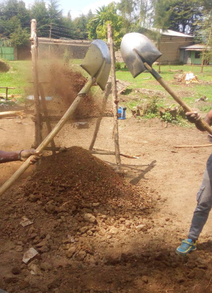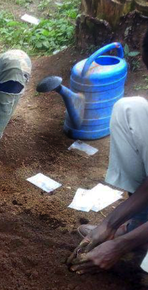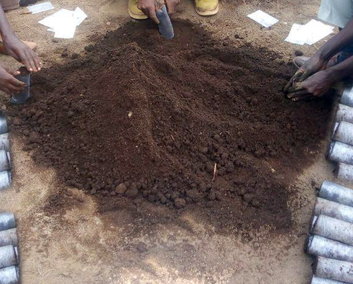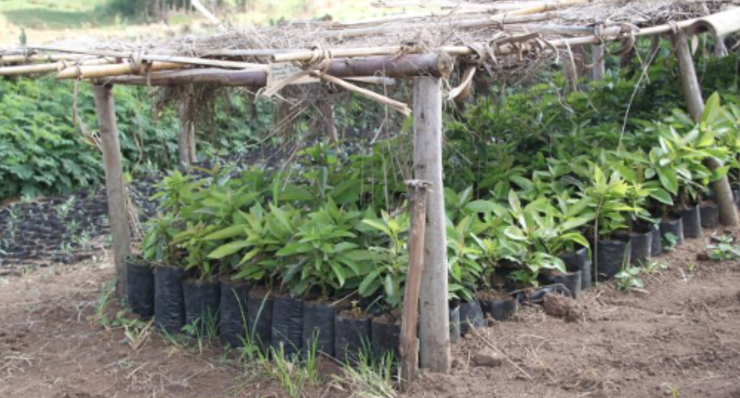Global ecosystems are at risk. In Africa and elsewhere in the world excessive levels of consumption is driving the loss of biological diversity and is often leading directly to the degradation of essential ecological processes that ultimately impacts climate regulation processes and our provision and access to high quality water.
To preserve the water, flora and fauna of the Oromia regional state in Ethiopia - there needs to be a balanced cycle of water. Trees are a main anchor to draw water resources, attract fauna and create community balance.
A tree nursery has been established as one of the key goals for the 'Trees for Life' project. This community led tree nursery under the direction of ROBA is producing as part of its bi-annual output 10, 000 saplings. This number of tree saplings grown will continue to increase in time and offers both jobs and the promise of a more eco-resilient community that can support a wider breadth of flora and animals.
Trees by their nature act as a physical envelope or barrier to assist with climate variances from excess rain and erosion to water retention.
A variety of indigenous and hardy tree species are being seeded and grown by the Kofele community in Oromia region, Ethiopia. These include the following:
A tree nursery has been established as one of the key goals for the 'Trees for Life' project. This community led tree nursery under the direction of ROBA is producing as part of its bi-annual output 10, 000 saplings. This number of tree saplings grown will continue to increase in time and offers both jobs and the promise of a more eco-resilient community that can support a wider breadth of flora and animals.
Trees by their nature act as a physical envelope or barrier to assist with climate variances from excess rain and erosion to water retention.
A variety of indigenous and hardy tree species are being seeded and grown by the Kofele community in Oromia region, Ethiopia. These include the following:
Acacia senegal
Arundinaria alpina
Buddleja polystachya
Cordia Africanus
Cupressus lusitanica
Eucalyptus globulus
Hypericum revolutum
Juniperus procera
Pinus patula
Arundinaria alpina
Buddleja polystachya
Cordia Africanus
Cupressus lusitanica
Eucalyptus globulus
Hypericum revolutum
Juniperus procera
Pinus patula
To date the tree nursery continues to grow numerous different sapling species each of which is lovingly replanted into their own pots as they continue to grow and mature. More tree saplings are being seeded by the community across the seasons. It is expected that the tree nursery will be able to maintain bi-annual outputs of between 10-12,000 trees each growing cycle.
Setting up a tree nursery and creating healthy green verge spaces involve several steps including
i) preparing and airing the soil
ii) watering the soil and removing any unwanted plant roots or other impurities
iii) packing the soil into cylindrical sleeves
iv) cylindrical sleeves are packed one more with time with a final soil medium and then seeds are inserted into each roll
i) preparing and airing the soil
ii) watering the soil and removing any unwanted plant roots or other impurities
iii) packing the soil into cylindrical sleeves
iv) cylindrical sleeves are packed one more with time with a final soil medium and then seeds are inserted into each roll
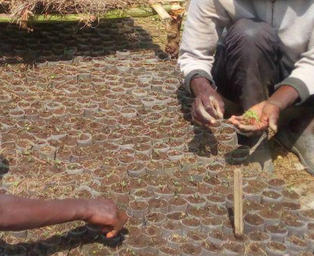
v) seeded plants (cylindrical sleeves) are protected by organic matting on top of the rows of plants
vi) plants are watered often to encourage sprouting
vii) when sprouts reach a good height, these are transferred to pots and watering at the nursery continues
viii) potted trees are transported and are safely moved to outer town and home sites to increase green verge planting
ix) community members continue to manage and protect newly planted trees from animals and water until they reach at least 1.5 m
vi) plants are watered often to encourage sprouting
vii) when sprouts reach a good height, these are transferred to pots and watering at the nursery continues
viii) potted trees are transported and are safely moved to outer town and home sites to increase green verge planting
ix) community members continue to manage and protect newly planted trees from animals and water until they reach at least 1.5 m
SUCCESS STORIES FROM THE KOFELE TREE NURSERY
|
|
Agropastoralist, Tiyu Guru, describes in his native language, Afaan Oromo, the benefits of having access to a local tree nursery established by ROBA in order rehabilitate the land. In particular in Ethiopia transportation costs can be prohibitive and by having a tree nursery in the local area many agropastoralists can gain access to a variety of tree seedlings without being overwhelmed by fuel and delivery charges. By planting trees, locals have gained the benefit of further food security, diversification of crops and an ability to increase and support natural assets. Tree growing has also provided locals with access to timber resources that can assist in the development of their own housing. Of note large mature tree branches are harvested rather than the whole plant being cut for timber. The production of local regenerative timber plants is of great assistance since it removes the burden and stresses of farmers from taking on additional debt and/or loans to pay for the transport and costs of construction materials brought into the local area.
English language summaries of Tiyu Guru's Afaan Oromo language interview can be found at these intervals in the video at 50s, 2min and at 3min10s. Video produced and edited by Geleta Aman, 2022 |
|
An Afaan Oromo elder and leader speaks about the key benefit of having a tree nursery established in his village of Moke Borko Kebele. While his village is only 10 km away from ROBA's Kofele tree nursery the costs of transport of several thousand trees were so prohibitive the growing season before it added unnecessary costs that hampered their own land rehabilitation projects. Rather than bearing and losing the community's wages against fuel charges again the Elder has asked ROBA if they could assist their village in establishing their own tree nursery. The establishment of a tree nursery will ensure that Moke Borko Kebele becomes self-sufficient now and into the future. A community with its own tree nursery has an ability to ensure villagers can access and grow specific trees particular to their own environment in order to help fight against climate. Trees grown in Moke Borko Kebele will also be used for food, shelter, medicine, and animal fodder.
English language summaries of the Elder's Afaan Oromo language interview can be found at these intervals: 50s, 1min30s and at 3min30s Video produced and edited by Geleta Aman, 2022 |
|
Resources
To learn more about tree nursery care and agropastoral activities search the
World Environmental Library
